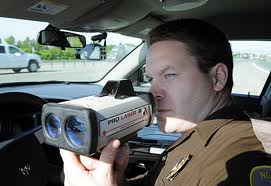High resolution lenses for machine vision — standard and custom lens design
How Does a Laser Speed Gun Work?
High Resolution Lenses for machine vision, instrumentation, inspection and vibration-sensitive applications. Standard and custom hi-res lens assemblies.

Laser Diode Lens
While you’re driving down the highway you have probably noticed police officers pulled to the side of the road or hidden behind a building or tree pointing a laser speed gun at vehicles driving by trying to catch unsuspecting speeders. You may have even been one of those unsuspecting speeders. It’s common knowledge that those guns they’re holding up are capable of recording the speed of cars driving past, but how exactly do they work?
The laser speed gun utilizes an infrared laser lens that shoots a beam at cars going by. The laser beam is then reflected off of the car and back to the speed gun. The laser speed gun measure the roundtrip time it takes for the laser beam to reach the car and reflect back. Light from a laser moves at an extremely fast pace (about 984,000,000 feet per second) so it can accurately calculate how fast an object is moving.
Laser speed guns shoot a very short burst of infrared laser light at a very high speed giving officers the ability to get about a thousand samples per second. These samples are divided by two and give a very accurate reading of how quickly the car is moving.
The main advantage for police officers using a laser speed gun is that the size of the cone of the laser is very small. This gives them the opportunity to target specific vehicles they might suspect are speeding. Laser speed guns are also very accurate. Because light moved much faster than sound they are able to more accurately tell the speed of a car than a normal radar gun would be able to.